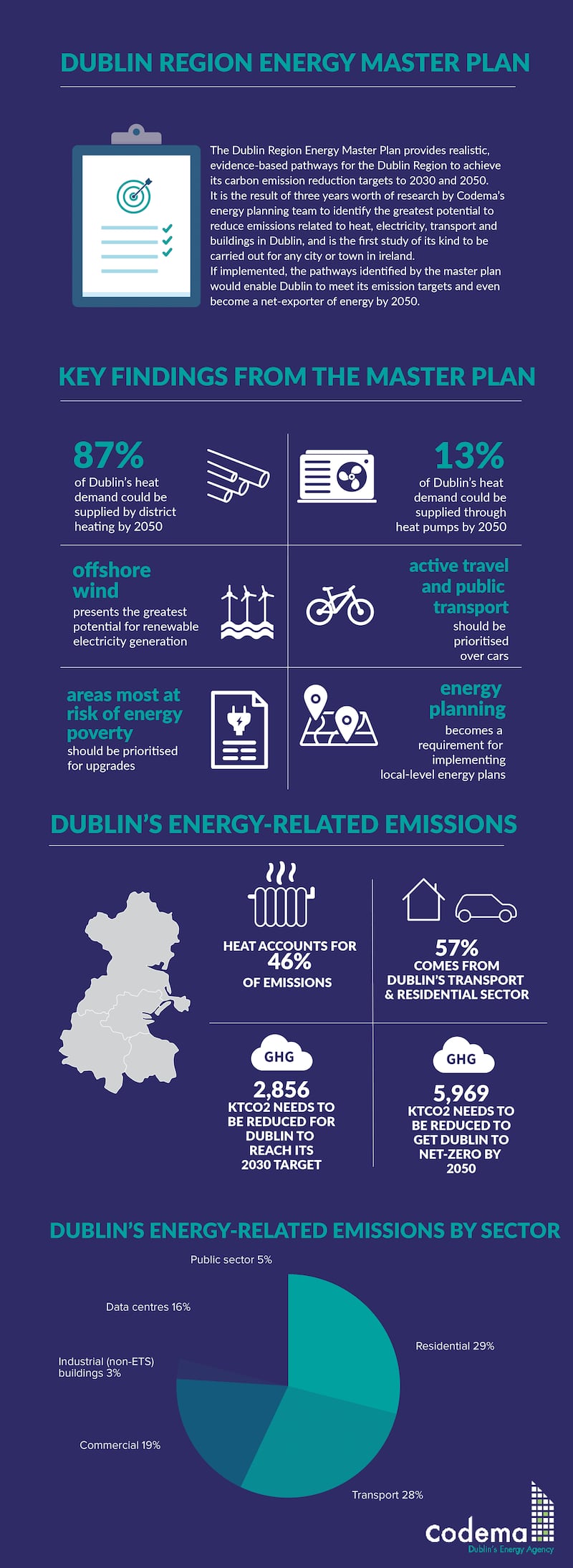Dublin can meet its 2050 emission reduction targets and become a net exporter of energy, according to research from the capital’s energy agency Codema.
Despite warnings from the Environmental Protection Agency (EPA) that the State risks missing its climate change goals, a three-year study by Codema found Dublin had the potential to buck the national trend and provide energy for use outside the capital.
The Dublin Region Energy Master Plan has identified “realistic, evidence-based solutions” to reduce emissions related to heating, electricity generation, transport and buildings, said the agency, which advises the four Dublin local authorities.
Heating accounts for the majority of energy-related emissions within the Dublin region (46 per cent), followed by transport (28 per cent) and electricity (26 per cent), but Codema said the master plan had identified measures to reduce emissions in each of these sectors.
READ MORE
Offshore wind power offered the “greatest potential” to generate renewable electricity in Dublin and could produce enough power for the equivalent of 1.2 million homes by 2030 and more than three million homes by 2050, Codema said, allowing Dublin to export electricity beyond its borders.
The plan also identified heat pumps and district heating, where waste heat from industry such as the Ringsend incinerator can be used to warm homes, as having “a significant role to play”. There was “the potential to supply 87 per cent of Dublin’s total heat demand through district heating networks by 2050”, it said.

“The results of the master plan also highlighted how there are enough renewable and waste heat sources in Dublin to heat the equivalent of 1.6 million homes, which — if utilised — could reduce Dublin’s fossil fuel bill by almost €1 billion per year,” it said.
However, the transport sector posed “a significant challenge for Dublin”, it said, with 65 per cent of the capital’s transport emissions coming from cars. While electrification of vehicles would make some contribution to lowering emissions, this alone “will not solve Dublin’s transport problems”, Codema said.
“Even if the Government’s ambitious EV targets are met, the number of kilometres driven by fossil-fuelled cars in Dublin will still need to be reduced by at least 23 per cent, in order to meet the 2030 emissions target,” it said.
“Therefore, a key recommendation from Codema’s research is that active travel and buses should be prioritised over cars in Dublin and that additional powers are provided to the local authorities to trial the reallocation of existing road space to more accessible, efficient and sustainable modes of transport.”
Codema’s research used “spatially-driven energy scenario modelling”, meaning it looked at every district in the capital and assessed the technologies that are best suited to reducing energy-related emissions within each.
In relation to building upgrades, the research was able to identify areas in Dublin most at risk of energy poverty, with the recommendation that these be prioritised for energy-efficiency upgrades.
The study also highlighted the many benefits of moving Dublin away from fossil fuels, such as an increase in direct jobs by 182,500 by 2050, a decrease in energy costs of €519 million per year through renewable energy technologies, as well as lower levels of pollution, improved air quality and better health benefits for those living and working in Dublin.
“If all of the recommendations within the Dublin Region Energy Master Plan were carried out, it would result in avoided external costs of over €24 billion, based on a comparison of the shadow price of carbon to the total avoided emissions over the lifetime of the master plan.”











